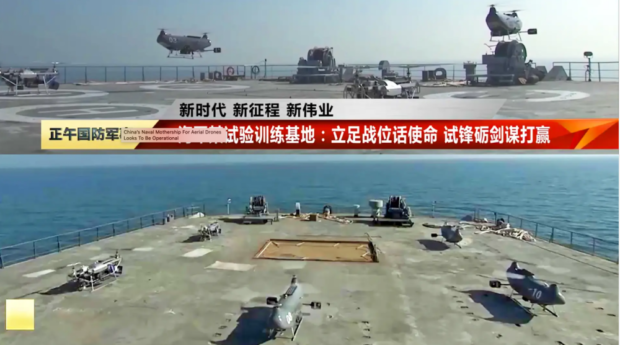China’s People’s Liberation Army Navy, or PLAN, appears to have put an unusual catamaran drone mini-carrier into service as part of an experimental naval training force.
[ In May 2021 we reported that China looks to have launched an odd mini-aircraft carrier of sorts that is intended to launch and recover small aerial drones earlier this year. A model of this catamaran vessel appeared at the Zhuhai Airshow, where it was ostensibly described as a platform for mimicking enemy “electronic” systems during training exercises. -Ed.]
Footage of what appears to be the training ship was included in a short segment broadcast on Chinese state television station CCTV-7 recently about what is described as a “Navy Experimental Training Base,” according to a machine translation. CCTV-7 is focused on news about the People’s Liberation Army (PLA). Overall, the segment shows various land-based and maritime training and/or test and evaluation activities involving shore-based systems, surface warships, and submarines, with a clear emphasis on naval countermeasures and other shipboard self-defense systems.
The b-roll running in the background during the CCTV-7 segment includes two brief and distinct clips showing what appears to be the forward flight deck of the catamaran drone carrier. Though a full view of the ship is never given, a number of very unique features are visible that are similar if not identical to those seen on a model of the vessel that the state-run China Aerospace Science and Industry Corporation, or CASIC, had on display at the 2021 Zhuhai Airshow. These include two large anchor line reels at the bow and five landing pads for drone helicopters.Interestingly, one of the two clips that CCTV-7 included in its segment today shows the helipads marked with circles with the Latin letter “H” in the center, while the pads in the other look to be unmarked. This would seem to indicate that the two videos were taken at significantly different times.
This may also raise a question about whether the PLAN has more than one of these ships, though this seems less likely. There have been no indications one way or another that a second one was launched after the first was last year.In addition, a number of the uncrewed helicopters seen in both clips shown on CCTV-7 are of a distinctive tandem-rotor design, a relatively uncommon configuration for uncrewed rotorcraft, which was showcased along with CASIC’s model of the catamaran training vessel at Zhuhai last year. These are readily identifiable by a bar underneath one end of the fuselage with what has looked to be a radiofrequency signal emitter of some kind installed on either end. Their portly fuselages would provide space for additional mission systems.
These drone helicopters may be a variant or derivative of the ZC Aviation ZC300, which the PLA has at least evaluated in the past as a way to transport small cargoes. ZC Aviation’s website, which does not appear to have been updated in any significant way since 2020, shows additional versions configured for agriculture and fire-fighting work, but none for obvious military use. This drone was reportedly developed in cooperation with Hainan Tropical Ocean University, and there was talk in the past about the possibility of equipping examples with laser-imaging sensors and small radars ostensibly for “oceanic observation research.”
The clips also show another tandem-rotor drone helicopter design that looks to be similar in size to the possible ZC300-based type, but that has a much more stripped-down, open-framed design.

